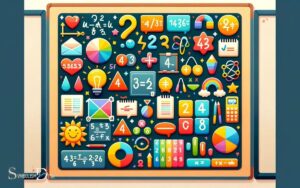Symbol for Opposite in Math: Negative Sign
In mathematics, the symbol for opposite, or additive inverse, is typically represented by a negative sign (−) placed in front of the number or expression. For example, the opposite of 5 is −5.
The concept of the opposite in mathematics refers to the additive inverse of a number, which is the number that, when added to the original, yields zero. This is a fundamental notion in arithmetic and algebra.
The symbol for the opposite is straightforward—it’s the same as the symbol for negation or subtraction:
For example:

Key Takeaway
Understanding the Concept of Opposites
The concept of opposites in mathematics refers to pairs of numbers that have the same magnitude but opposite signs. In simple terms, if one number is positive, its opposite is negative, and vice versa.
For example, 5 and -5 are opposites as they are equidistant from zero on the number line but lie on opposite sides. Understanding the concept of opposites is crucial in various mathematical operations, such as addition, subtraction, and solving equations.
When adding or subtracting numbers, the concept of opposites helps in simplifying expressions and solving problems.
Moreover, in real-life applications, such as in physics and finance, the understanding of opposite numbers is fundamental for representing quantities in different directions or with different implications.
The Significance of the Minus Sign
In the context of mathematics, the significance of the minus sign lies in its ability to represent negative numbers.
Understanding the impact of negative numbers is crucial in mathematical operations, as they can alter the outcome significantly. It is important to recognize the implications of the minus sign in various mathematical contexts.
Importance of Negative Numbers
Understanding the significance of negative numbers is crucial for grasping the abstract nature of mathematical operations.
Negative numbers are not just arbitrary symbols; they represent real-life situations where values are below zero, such as debts, temperatures below freezing, or losses.
Realizing this significance can evoke a sense of clarity and empowerment, as it allows us to comprehend and solve problems that arise in various fields, from finance to science.
Furthermore, realizing that negative numbers are an essential part of the number system can lead to a deeper appreciation for the elegance and completeness of mathematics.
This understanding can be both intellectually satisfying and practically beneficial, providing a foundation for more advanced mathematical concepts.
Effect on Mathematical Operations
Demonstrating the impact of negative numbers on mathematical operations is essential for understanding the significance of the minus sign.
The minus sign not only indicates the concept of “opposite” or “subtraction” but also affects various mathematical operations.
In addition to its role in subtraction, the minus sign denotes negative numbers, which in turn influence addition, multiplication, and division.
When negative numbers are involved, addition becomes a combination of adding and subtracting, multiplication introduces the concept of opposite signs resulting in a negative product, and division encounters the complexities of negative quotient and divisor.
Understanding the effect of negative numbers on these operations is crucial for a comprehensive grasp of mathematical concepts and their real-world applications, as they frequently involve both positive and negative values.
Expressing Negation and Additive Inverse
How can mathematical expressions be used to denote negation and additive inverse in a precise and professional manner?
In mathematics, negation is denoted by the use of a minus sign (-) placed before a number or expression. This signifies the opposite or inverse of the given value. Similarly, the additive inverse of a number is the value that, when added to the original number, results in zero.
It is denoted by placing a negative sign (-) before the number.
These notations are essential in various mathematical operations and equations, providing a clear and concise way to represent opposites and inverses.
- Understanding the concept of negation and additive inverse can bring a sense of clarity and precision to mathematical expressions.
- It can evoke a feeling of confidence and mastery in handling mathematical operations and equations.
Usage of the Symbol in Equations
How is the symbol for opposite utilized within mathematical equations to denote negation and additive inverse? The symbol for opposite, typically represented as a minus sign (-), is used in equations to indicate the negation or additive inverse of a number.
When the symbol precedes a number, it signifies the opposite value, changing its sign from positive to negative or vice versa.
For example, in the equation x + (-3) = 7, the symbol for opposite is used to denote the additive inverse of 3, resulting in x = 10.
Similarly, in the equation -(-5) = 5, the symbol signifies the negation of -5, resulting in a positive value of 5. The symbol for opposite plays a crucial role in balancing equations and solving for unknown variables.
Impact on Mathematical Relationships
The symbol for opposite in math influences the direction of mathematical relationships, providing a means to represent negation and additive inverse within equations.
This impacts mathematical relationships in the following ways:
- Clarity: The symbol enhances clarity in expressing the opposite value, aiding in understanding the relationships between positive and negative numbers.
- Emotional Response: It can evoke a sense of relief and confidence in navigating mathematical operations with ease.
- Consistency: It maintains consistency in mathematical operations, ensuring that the rules of arithmetic are applied uniformly.
- Emotional Response: This fosters a feeling of trust and reliability in mathematical processes.
Understanding the impact of the opposite symbol on mathematical relationships is essential for handling algebraic inequalities, which we will explore next.
Handling Algebraic Inequalities
Handling algebraic inequalities can be approached with a nuanced understanding of the symbol for opposite in math, influencing the direction of mathematical relationships and providing a means to represent negation and additive inverse within equations.
When dealing with algebraic inequalities, it’s crucial to apply the principles of the symbol for opposite to maintain the integrity of the inequality.
Multiplying or dividing by a negative number, for example, reverses the direction of the inequality, highlighting the significance of the symbol for opposite in preserving the accuracy of the relationship between the terms.
Moreover, when adding or subtracting a negative number from both sides of an inequality, the symbol for opposite plays a pivotal role in ensuring the validity of the resulting expression.
By understanding and utilizing the symbol for opposite, one can effectively navigate and solve algebraic inequalities with precision and clarity.
Practical Applications in Math
The practical applications of math are essential for understanding real-world problem-solving, simplifying complex equations, and comprehending negative numbers. These points serve as the foundation for how math is used in various fields, from engineering to finance.
By applying these concepts, mathematicians and professionals can tackle challenges and make informed decisions based on quantitative analysis.
Real-World Problem-Solving
Effective problem-solving in mathematics involves applying theoretical concepts to real-world scenarios, requiring practical applications and critical thinking skills. When students grasp the practical applications of math, it opens a world of possibilities.
Consider the emotional impact of these real-world problem-solving scenarios:
Empowerment
- Solving real-world math problems empowers individuals to navigate everyday challenges with confidence.
- Understanding how math applies to the real world can make individuals feel more capable and in control of their lives.
Relevance
- Recognizing the practical applications of math makes learning more engaging and relevant.
- Connecting math to real-world problem-solving helps individuals understand its significance in their daily lives, fostering a sense of appreciation and motivation.
Simplifying Complex Equations
Simplifying complex equations in mathematics involves identifying patterns and relationships to streamline the representation of mathematical concepts.
This process allows for easier manipulation of equations and a clearer understanding of their fundamental properties. Practical applications of simplifying complex equations can be found in various fields such as engineering, physics, and economics.
For instance, in engineering, simplifying complex equations is essential for designing efficient structures and systems. In physics, simplifying equations helps in understanding the behavior of particles and forces in the universe.
Moreover, in economics, complex equations are often simplified to analyze market trends and predict future outcomes.
Therefore, the ability to simplify complex equations is not only a fundamental skill in mathematics but also an invaluable tool with numerous real-world applications.
Understanding Negative Numbers
Understanding the practical applications of negative numbers in mathematics is essential for comprehending various real-world scenarios and mathematical concepts.
Negative numbers are not just theoretical, but they are used in everyday life and can represent a range of situations.
Consider the following emotional response-evoking examples:
Financial Struggles:
- Visualize the stress of being in debt, where negative numbers represent the amount owed, and positive numbers represent available funds.
Temperature Extremes:
- Imagine the discomfort of experiencing sub-zero temperatures, where negative numbers illustrate the severity of the cold.
Conclusion
The symbol for opposite in math plays a crucial role in expressing negation and additive inverse, as well as in solving equations and handling algebraic inequalities. The symbol for opposite in math plays a crucial role in expressing negation and additive inverse, as well as in solving equations and handling algebraic inequalities. In certain contexts, understanding the upside down T symbol meaning becomes equally important, as it often represents concepts like orthogonality in linear algebra or logical negation in formal logic. By mastering these symbols and their meanings, students and mathematicians can develop a deeper understanding of mathematical relationships and problem-solving strategies.
Its impact on mathematical relationships is significant, and it has practical applications in various mathematical concepts.
The understanding and usage of this symbol are fundamental in mathematical study, and its importance cannot be overstated. Its versatility and widespread application make it an indispensable tool in the world of mathematics.






